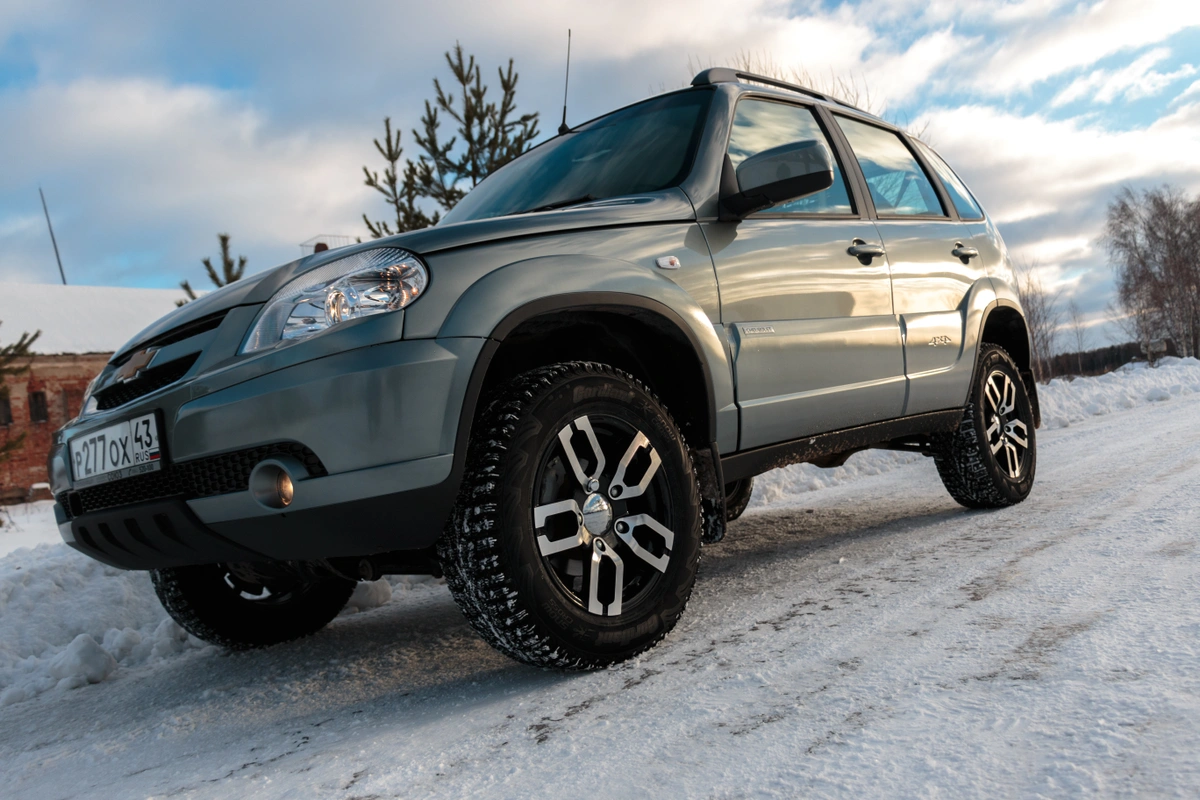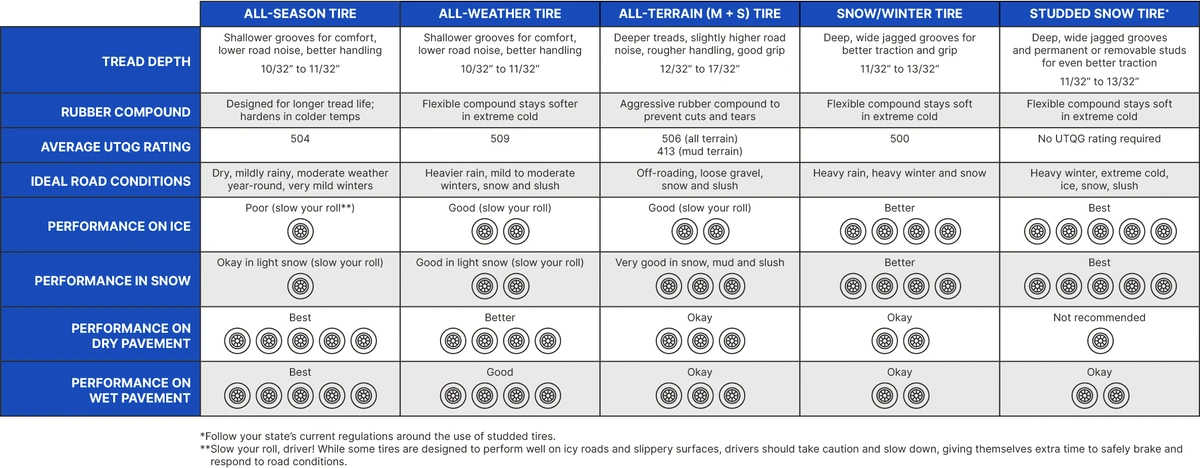Your Shopping Cart
Your cart is empty.
Subtotal ( items)
Instant Rebate Applied:
Promo Code Applied: ID.me Discount Applied:
Have a Promo Code?
Size:
Item
Item
Selected for:
/ each
Add-Ons
Wireless air pump capable of pumping up to 150 psi with 2000 MAH power bank.



Fully protect your clothes and vehicle interior during transportation of your tires. For Tires up to 31" tall and wheels up to 22".
Per sensor
Add TPMS Sensors
/per sensor
Please confirm the make, year, model and trim of the vehicle you want to purchase for:
How many sensors do you need?
The vehicle you have selected is not compatible with aftermarket TPMS Sensors.
Enter a different vehicle to add TPMS sensors

 Front Tire Size:
Front Tire Size:
 Rear Tire Size:
Rear Tire Size:
 Your Vehicle:
Your Vehicle:
Pros & Cons of Staggered Fitment

Attractive Design

Improved Handling

Improved Cornering
Bumpier Ride
Poor Traction in Snow
How do I find my tire size?



Need help?
 Your Vehicle:
Your Vehicle:
Pros & Cons of Staggered Fitment

Attractive Design

Improved Handling

Improved Cornering
Bumpier Ride
Poor Traction in Snow
How do I find my tire size?



Need help?
Pros & Cons of Staggered Fitment

Attractive Design

Improved Handling

Improved Cornering
Bumpier Ride
Poor Traction in Snow
Need help?
Need help?
How do I know if I have an LT tire?

 Your Vehicle:
Your Vehicle:
Sorry, we could not find any available
wheels for your sizing selections.
Need help?
Guide to Winter Tires, Snow Tires and Best Wheels/Rims for Winter Driving
By Tire Agent Staff
August 31, 2023
(This is a refreshed post, originally published September 16, 2022.)
Do you need to put snow tires on your car in winter? Are they really necessary? Or are all-season tires good enough? What makes snow tires for cars different from regular tires? And, Cheap Charlie wants to know: Can you go with just two snow tires or should you get all four? Do you need to get special rims for winter tires?
Read on as we explain what each tire type is designed for, so you make the best decision for your vehicle and safety.
Is There a Difference Between Winter and Snow Tires?
This chart below is a side-by-side comparison of five types of tires. You can see that all season tires versus snow tires make sense if you live in areas that get heavy snowfall. You can also compare all terrain vs all season tires in snow and see that all seasons are OK in light snow at slower speeds, while all-terrain tires tend to perform better because their deep treads push snow and slush away from the vehicle.
This is a great place to begin: Understanding which tires are safest for driving on ice, sleet, slush and snow. That's where winter and snow tires come into the picture. But what's the difference?
Honestly, they are very similar. In fact, most tire manufacturers don't distinguish between winter tires vs snow tires. It all comes down to the materials used to make them and how they handle cold weather and snowy, icy conditions.
Have you ever seen the snowflake symbol on the sidewall of a tire? That symbol means the tire is built to handle better in snowy conditions. You'll see this symbol on what are considered snow tires and winter tires.
Winter tires are built to handle more harsh weather conditions than just snow. They are made with materials that perform in temperatures below 44 degrees Fahrenheit. That's 7 degrees Celsius for those using the metric system.
What Makes Snow Tires Different?
What makes snow tires different is they typically have deep, wide, jagged grooves that provide better traction and grip. They have the best tread design for snow and winter driving. Their flexible compound stays soft in extreme cold and is ideal for heavy rain, winter and snow. These are the tires for you if you live in an area with long cold winters and see reasonable amounts of snow.
You could be wondering why all-season tires aren't good enough for snow conditions since, you know, they're all-season and all. All-season tires offer some traction in light snow but are not built for deep snow, ice and frigid temperatures. We'll get more into all-season tires a little later.
Ready for studded tires?
If your winters are harsher, or you plan to drive in a snowy mountain area, you might want to consider studded snow tires. These are tires fitted with cleat-like protrusions to provide even more grip. Some models come with fixed studs, while others have divots where you can install studs when conditions call for them.
One thing to remember is that studded tires are not legal everywhere in the U.S. Some states allow them only during certain times of the year, and others never permit them. Check out our guide to studded snow tires for more info.
Can you use winter tires in the summer or warmer months?
It is not advised to use snow tires all year long. Long-term costs of leaving winter tires on year-round outweigh the costs of changing them seasonally. Your car's performance on the road may suffer if you don't.
The ideal decision for you will depend on several criteria, such as your environment, driving habits and performance requirements. This is why tire manufacturers offer different types of tires for different seasons. For more details, check out our article on when to change winter tires.
OK, now you know a little about winter, snow and studded tires, but what are the other options? Let's look at one of the most common selections first: all-season tires.
All-Season, All-Weather Tires vs Winter Tires
All-season and all-weather tires have similar traits, including shallow grooves for a comfortable ride, lower road noise and better handling.
Here's where the differences begin. All-season tires are designed for longer tread life, hardening in colder temperatures, and for dry, mildly rainy, moderate weather year-round and very mild winters. These are OK in light snow.
On the other hand, all-weather tires are made with a flexible compound that stays softer in extreme cold. They are perfect for driving in heavier rain, mild to moderate winters, snow and slush. These models are good in light snow.
What about all-season tires with snow rating? 
The name "all-season" should imply that they should work well in snow, right? The answer is a bit more complicated than that. As outlined above, the ideal snow tire has a rubber composition and tread pattern specifically designed for cold temperatures and uneven terrain. The more a tire leans toward these snow-optimal traits, the more it will sacrifice in other areas. Soft rubber works well with improving traction in snow, for example, but is uncomfortable to drive on during the summer.
All-season tires balance their design and are comfortable to drive in all less extreme conditions. For this reason, all-season tires work in light winter conditions but will struggle in deep snow or ice. The winter capability of a tire will generally be rated with a three peak mountain snowflake symbol. This symbol means that the tire has been tested in extreme winter conditions and meets the capability requirements of the U.S. tire Manufacturers Association (USTMA). All winter tires will have this rating.
So, What Are Mud and Snow Tires?
Mud and snow tires are all-season tires that the Rubber Manufacturers Association has approved for usage in muddy and snowy conditions. The M+S marking is typically found somewhere on the tire. You may hear them referred to as all-terrain tires.
These tires are designed with deeper treads, producing slightly higher road noise and rougher handling, but offering a good grip. They have an aggressive rubber compound to prevent cuts and tears and are good for driving off-road, on loose gravel, snow and slush.
For more information, here is our article listing the top three all-terrain tires in the snow.
How Many Snow Tires Do I Need?
If you're planning on driving in the snow, you need 4 snow tires.
Even if your vehicle is front- or rear-wheel drive, it can be potentially dangerous to just have 2 snow tires on your car during the winter. This is because the traction of your vehicle will be significantly different on the different ends of your vehicle. While making a turn or driving at high speeds in winter conditions, your non-winter tires could easily lose grip on the road, leading to one side of your vehicle sliding or "fishtailing."
This will happen regardless of whether or not those wheels have power applied to them. Your rear- or -front-wheel drive car still utilizes the non-powered tires to steer and break while driving. AWD vehicles use all four tires so it's doubly essential to use 4 winter-capable tires. It's generally not worth the risk to only drive on 2 winter tires.
What Are the Best Rims for Winter Tires?
We've outlined why you should swap your tires out during the winter, but what about your wheels?
Most car wheels are made of aluminum because it's lightweight and less expensive. However, in cold temperatures aluminum tends to change shape, contracting much more. The average car wheel is wide so that it can have a lot of traction with the road. In winter, wide tires can actually harm your performance as they have a harder time driving through snow. Smaller, narrow tires will push your vehicle's weight onto a more concentrated point and won't have as much snow to cut through.
The ideal winter wheel is both smaller and made of steel. Steel doesn't contract as much as aluminum in colder temperatures. A significant change in the size of your wheel can lead to an uneven ride and even leaks in air as your tire struggles to keep in contact with the wheel. If you're in an area that has significant temperature drops in the winter, especially at night, it's far safer to drive on wheels specifically manufactured to handle those conditions.
When you buy winter tires, it's smart to buy a set of winter rims. Both sets of rims (winter and all-season) will last longer, because the winter elements won't damage your off-season rims. Also, you'll save on installation costs, as tires on their own rims cost less to change.
And Now, Answers to a Few Random FAQs About Winter Tires and Wheels
Are my tires snow tires?
The aforementioned three-peak mountain symbol marks a tire as a winter, or snow, tire. This symbol is located on the sidewall of your tire. Besides this, if your tire has studs or particularly deep, blocky treads, it's likely a snow tire.
Are winter tires worth it? Do I need winter tires?
Whether or not winter tires are worth it for you will be dependent on where you live and how serious the snowfall is during the winter season. Even if you live in a snowy area, if your streets are regularly plowed and salted, it may be unnecessary to purchase winter tires. However, if you plan on driving in heavy snow, you'll be glad to have a set of good winter tires.
What are the best tires for icy roads?
We've talked a lot about snow tires, but what makes a tire good to drive on ice? Ice may be harder to notice on the road than snow but it's still very dangerous. Fortunately, many of the same principles that apply to improving traction on snow apply to ice. To prevent slipping or losing control while driving on ice, the soft rubber of winter tires can grip even slippery surfaces in low temperatures. Additionally, the increased number of narrow, jagged sipes in a winter tire will cut and dig into the ice to stay firmly gripped to the road. You should still be careful, though, as winter tires will not grant you immunity to losing control on the ice.
In a nutshell, what's the difference between snow tires and regular tires?
Regular tires are optimized for driving comfort while on the pavement whereas winter tires are meant for driving on snow and ice in low-temperature conditions.
Do all terrain tires count as snow tires? And, do all terrain tires work in snow?
No. All-terrain tires won't be made of the same soft rubber meant for low temperatures that winter tires used. The tread pattern of all-terrain tires is also meant for rocks, uneven surfaces, and the mud that you'll encounter of the road. Snow tires, on the other hand, are designed to dig and grip snow and ice.
Bottom line: Should I buy snow tires or all season tires?
Evaluate the winter conditions that you expect to encounter every year to understand whether or not snow tires are necessary. If you're in an area that doesn't have the roads plowed or expect to have to drive through snow regularly, snow tires are essential. But, even if you live in an urban or suburban area that experienced heavy winters, snow tires can be a safe investment to ensure you don't lose control of your vehicle when encountering snow or ice.
If you don't expect to encounter heavy winter conditions very often, you're probably safe with all-season tires.
Next Post:
Highway Terrain Tires: H/T Tire MeaningHow to Qualify for the $50 Offer
- Add items to your cart and begin checkout.
- Select PayPair and apply for financing.
- If you’re approved by a participating lender, you’ll see a $50 promotional rebate applied to your order total.
-
To receive the $50, you must:
- Complete your purchase with a qualifying lender,
- Agree to the payment terms,
- And make the required number of consecutive on-time payments, as specified by the lender.
Note: Offer available only through select lenders. Additional eligibility requirements and conditions apply. Rebate may be issued after verification of qualifying payment activity. Terms subject to change.
How to Purchase Tires and Wheels
With a Payment Plan
Tire Agent's payment plans make it easy to get the best partial or full set of tires and wheels for your vehicle.
It's fast, secure and won't affect your credit score
Match with multiple lenders
Why Choose PayPair?
PayPair’s Partners and Plans

No Money Down

No Money Down

No Credit Needed*

No Money Down

$1 to Start!*

No Money Down

No Credit Needed*

$1 to Start!*

No Money Down
Other Payment Plans

$0 to Little Down

Pay with your bank account

Simplified checkout experience

Faster and easier than using cards or cash

Simplified checkout experience

Faster and easier than using cards or cash
*SNAP: The advertised service is a lease-to-own agreement provided by Snap RTO LLC. Lease-to-own financing is not available to residents of Minnesota, New Jersey and Wisconsin. NO CREDIT NEEDED: Not all applicants are approved. While no credit history is required, Snap obtains information from consumer reporting agencies in connection with applications, and your score with those agencies may be affected. PAYMENT PLAN: The standard plan consists of renewable lease terms. To exercise an early ownership, consumers must make regular payments on time and schedule additional payments via the customer portal or by contacting Customer Care at 1-877-557-3769. KATAPULT: The Promotional Initial Payment (plus any applicable taxes and fees) is due at lease signing. Your lease-purchase payment amount will be determined after you select your product(s). You will not acquire ownership of the product(s) if the total amount necessary to acquire ownership is not paid. The Promotional Initial Payment does not reduce the cost of the lease-purchase agreement. The Promotional Initial Payment is only available when shopping at Tire Agent through the Katapult mobile app and at Tire Agent’s website. Product pricing subject to change and availability. Disclosure: 90-day early purchase option (EPO) terms and conditions apply: 90-Day (3 months in CA) You can buy out your lease-to-own agreement within the first 90-days. This amount includes the cash price, plus the lease-to-own cost for the first 90-days. Taking advantage of the 90-day purchase option will save you the most money! PROGRESSIVE: Ownership by rental/lease agreement with Progressive Leasing costs more than the retailer’s cash price. Select items only. Cancel or purchase early at any time. Not available in MN, NJ, VT, WI, WY. Progressive Leasing obtains information from credit bureaus. Not all applicants are approved. Standard agreement offers 12 months to ownership. 90-day purchase options cost more than the retailer’s cash price (except 3-month option in CA). To purchase early or to cancel lease, you must call 877-898-1970. Retailer cannot activate early purchase options.


